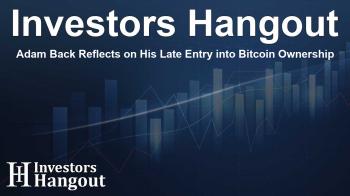Adam Back Reflects on His Late Entry into Bitcoin Ownership

Adam Back's Surprising Admission About Bitcoin
Adam Back, a prominent name in the realms of cryptography and blockchain, recently made a surprising admission about his early relationship with Bitcoin (BTC). Despite being a pivotal figure known for founding Hashcash in 1997, a vital proof-of-work algorithm aimed at filtering spam and thwarting denial-of-service attacks, he did not actually own any Bitcoin until 2013.
The Role of Hashcash in Bitcoin's Development
The Hashcash algorithm significantly influenced the Bitcoin mining process, serving as a foundational element of the cryptocurrency's proof-of-work model. Back’s contributions were so impactful that they earned him a mention in Satoshi Nakamoto's 2008 white paper, illustrating his crucial role in the genesis of Bitcoin. This connection underscores the irony that despite his early involvement, Back did not engage with Bitcoin during its infancy.
Early Days of Bitcoin: A Missed Opportunity
Back has openly expressed regret over not owning any Bitcoin prior to 2013, particularly during the cryptocurrency's formative years around 2009 when it was quietly emerging from the cypherpunk community. He candidly remarked on how he considered himself "an idiot" for not purchasing or mining Bitcoin during that period.
The Transformation Since 2013
Following his initial cautious approach, Back finally made his first purchases of BTC in 2013, just as Bitcoin was beginning to gain broader acceptance and recognition. Over the ensuing decade, the value of Bitcoin skyrocketed, with an increase of at least 50,000%, marking a revolutionary change in the financial landscape.
Adam Back and Blockstream's Innovations
In addition to his Bitcoin journey, Back played an instrumental role in founding Blockstream, a company dedicated to developing advanced blockchain technology. Blockstream has been at the forefront of several critical innovations, including the introduction of sidechains, the Liquid Network, and the Bitcoin satellite network, all aimed at enhancing Bitcoin's scalability and accessibility.
Bitcoin's Ongoing Influence
The global market capitalization of Bitcoin has surpassed $2 trillion, a testament to its growing influence. Adam Back's work continues to shape the future of cryptocurrency and blockchain technology, reinforcing his legacy within the industry.
Frequently Asked Questions
What did Adam Back invent?
Adam Back invented Hashcash, a proof-of-work algorithm critical in the development of Bitcoin.
When did Adam Back first buy Bitcoin?
Adam Back made his first Bitcoin purchase in 2013, several years after Bitcoin's inception in 2009.
What is Blockstream?
Blockstream is a blockchain technology company co-founded by Adam Back, focusing on innovations like sidechains and the Liquid Network.
How much has Bitcoin increased in value since 2013?
Since 2013, Bitcoin has increased in value by at least 50,000%, showing remarkable growth.
Why does Adam Back regret his early Bitcoin decisions?
Adam Back regrets not buying or mining Bitcoin earlier due to its significant increase in value and potential during its early years.
About Investors Hangout
Investors Hangout is a leading online stock forum for financial discussion and learning, offering a wide range of free tools and resources. It draws in traders of all levels, who exchange market knowledge, investigate trading tactics, and keep an eye on industry developments in real time. Featuring financial articles, stock message boards, quotes, charts, company profiles, and live news updates. Through cooperative learning and a wealth of informational resources, it helps users from novices creating their first portfolios to experts honing their techniques. Join Investors Hangout today: https://investorshangout.com/
Disclaimer: The content of this article is solely for general informational purposes only; it does not represent legal, financial, or investment advice. Investors Hangout does not offer financial advice; the author is not a licensed financial advisor. Consult a qualified advisor before making any financial or investment decisions based on this article. The author's interpretation of publicly available data shapes the opinions presented here; as a result, they should not be taken as advice to purchase, sell, or hold any securities mentioned or any other investments. The author does not guarantee the accuracy, completeness, or timeliness of any material, providing it "as is." Information and market conditions may change; past performance is not indicative of future outcomes. If any of the material offered here is inaccurate, please contact us for corrections.
